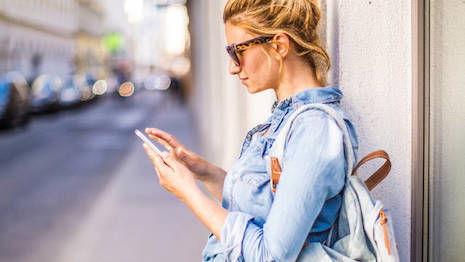While mobile phones are increasingly being used by consumers for purchases, they can also play a key role at driving in-store traffic for retailers through search.
According to a new report from Uberall, more than 80 percent of consumers are using their mobile phones to search for retailers, products and more that are near them at the moment. Leveraging the keywords “near me” and gaining visibility in these localized searches is a key way to get consumers in the door.
"'Near me' searches provide a major opportunity for luxury brands," said Josha Benner, cofounder and CRO of Uberall.
"Most of today’s shoppers still purchase luxury items in brick-and-mortar stores, making easy discovery even more important," he said. "And, as our survey shows, 'near me' searches are one of the most useful and popular ways for people to find out which stores are in their direct vicinity.
"By showing up in these searches, luxury brands can increase the number of people coming into their stores."
The first annual “Near Me Shopping Report” from Uberall is based on a study of more than 1,000 people on their “near me” search behavior.
Mobile marketing
About seven in 10 consumers use their smartphone to facilitate shopping tasks, the most popular of which is researching products. Consumers also turn to their phones to compare prices or look for deals.
Showing the importance of mobile to bricks-and-mortar retail, more than half of those who use their phones for shopping seek out store hours or locations.
Earlier this year, Google shared data that showed that searches for the phrase “near me” have spiked in the last couple of years. Since 2016, the tech company has seen searches for “near me now” grow 150 percent.
Specifically, Google has noted a 200 percent growth in the use of the combination of “open,” “near me” and “now” on mobile devices. The number of mobile searches that ask where to buy specific items nearby has also risen by 500 percent.
According to Lisa Gevelber, vice president of marketing for the Americas at Google, searches that make use of these terms indicate consumers’ purchase intent. These queries are also typically aimed at satisfying an immediate need, whether for shopping or restaurants.

Consumers use mobile to find products near to them. Image credit: Neiman Marcus
Uberall found that the majority of consumers have used the terms “near me” to find localized results. While 82 percent of all respondents say they have done a “near me” search, 92 percent of millennials have done so.
Consumers are most apt to search for a specific store near them. Following that, they are likely to look for a product, with searches for specific brand names less common.
Food is the top category for “near me” searches, but about 40 percent of consumers ask about products such as apparel and accessories and personal care.
For brands looking to capture consumers as they search, Uberall found that this type of research is one in which the top results win. Ninety-three percent of those surveyed said they were at least somewhat likely to click on one of the first three links that appear.
"Optimization means having a comprehensive digital footprint online," Mr. Benner said. "Luxury brands can use SEO to move to the top of search results, which can ultimately make or break a business in today’s mobile-centric landscape.
"And they can boost their SEO by using Web sites, mobile apps, store locators, search engines, maps and GPS, social platforms, advertising networks and more," he said. "These are all effective methods that can really go a long way in helping luxury brands boost their visibility and rankings in searches."
Purchase path
Lending more credence to the undeniable correlation between in-store visits and mobile purchases, research from xAd revealed that two out of three U.S. consumers venture into bricks-and-mortar locations to supplement product research undertaken on smartphones.
XAd’s 2016 Mobile Path to Purchase report, done in collaboration with Millward Brown, studied how individuals in five different countries leverage their mobile devices to make retail-related purchases. The findings corroborated the notion that in-store visits still play a crucial role in driving sales on smartphones, as customers appreciate being able to see and experience a product in real-life before using digital channels to search for price comparisons and reviews (see story).
Luxury consumers are increasingly using digital channels within their purchase paths, with a mere 22 percent starting and ending their journey offline.
A new report from McKinsey entitled “The age of digital Darwinism” highlights luxury brands’ growing need for digital competency, as even boomers spend significant time online and on smartphones. Whereas the conversation in the last few years has largely been about translating a luxury experience to a screen, McKinsey now sees expectations hinging on digital impacting the bricks-and-mortar environment (see story).
"Shoppers use mobile in a number of important ways," Mr. Benner said. "While many people are buying directly from devices, there’s also a large population using mobile as a research companion before buying in-store.
"Google data finds that 70 percent of smartphone users who bought something in a store first turned to their phone for information about that purchase," he said. "If brands and marketers want to be competitive in-store or online, they simply must become discoverable on mobile devices."
{"ct":"Pvi0BcAkosMVaPnvsMA6+rbZUJn3frPIKATrceZx4CQAalEaCfJl5VALefE4isFXBOESfmJTEOfpubUnZXXJH3SfiMHaXheqJDGmDrus4Go6hUz78fFMueBlteDfaUHE4OKhPkokNVt8gwxdb4GsvunOO37R\/6HqETHC8cgSMcIOuAws4eNN9MG23a2zT7vdU+ffNNlNNfugEYGOj6B9dKcOh3Zw2EdEyjNpp5jsjJGsBZ\/kcNWooXUEq0qgi3hZPw3IQwkZN\/bFeKitNMKIIPDx7IjEgd2ubLm1aA7IgntKhNsJ8QPsFsPvjykDiwMtY58t2LpIj3l+6qHl+yY8gAqiDiFAXh\/KI5EQeVzg6YyNBiSiEhbAtnlkhBaAz7ut3HX8PACAHaO5Qge29mhyEdvL7LRxvY6HTqxXOZGrNYfOWuA7joCGZdKp19T8NKnCEPDKhVMTFnke1oUiDQLuLC5odPgGcSH9VvAS8Fec0ZxGEzd+z8vIBbiMLnZNrE5mToBiIh7dRnr9THJIM5BZ1KCx7skm0ESBkvoYFsRIkcXQOdqmQwSGhTSyd6NHuiFggmCLH\/PBbz\/jMpi8OXE9xOGfwHfEjJMrt7ZCXo\/FF764mdijcSx+vGh091YxBQNOV59ZXVgdtX9F3NuhV0JkAGz2UtDa74kCfsxXV9kkG4DVED7U9aLN755BV+P7wfXTaqvnNrpQN+liz3S7e6FlB4PcQMf5O\/nlyHFhO+fPeTcM+yKtBLzarJ0ZDQgVwvWe5qK5BjiTAJMZgZZOjFuqocITvv9QLI74\/G5YdV6rPtNQXePd\/cJrbLI6g0GgsF\/4IL87UC0ozVyhQYkH\/6Dv8UJ+XPixM2WqqwIH5Uo7XtkJn7ZrLtawM2u8jeI5FWBLrfK6lDM2dZza4mraHv3UBSzuuRP9LNPKO0RA\/EV5hojCd9HYkaK8FQ2UGfIDpOeZBbAPWEuSvCMp5ugcXNBuc1vj0VTWDaaj3fMEYm9ppx1uGDcURlH3zx3T53PkjJK+\/jBVSwQSaPQDB342iY66f1l9wloOkNHoHrY11KUR0bjr\/rIJquyEkyKvO6MI1G850LpI6NcleQVR9HEg5W\/xDWfG7oYSV9RQfA8AtwlsJNpm0Xy3eyjj+VwWvsMFx1U+vzzsjsLItXD0tj4r0IMRqLMR87Fx4ywdDZQrsGWgVvS9n8xWSIeWViuVcFN7pYdDXWFWnHY9liUionyYweMSr\/LfQG2t1QcmG3Gh0LxCz3e8Xcv2NovHLw4j3f45sEpJJ4Sk0iXUB691tKEufLZ3Zw3JvuXf899JUb2DgtP\/qVg1sXsIAWJKjp7ND5cb1cGY6Ypl54WOdX581lzgZN1EufFN6fTKItS3sgbUHZ5Q4U1meDixFOfVrnoaqCp4XGrLUIjSkg6DTy1rleFlH8lJ6FlKUTIbngAiGtZF31M4E10Bc11xOk\/LujSUulwrAnW3sfjZ4AgcFVKk7MIsBAJNUTJ0UycOQnbJAqwGGThp+fZxSUWHUl07xlMkp4\/\/ypn3ywafJJoA3VGUX1lm8q+1mYrUOIJ1blR83AQINcdxKXiIwGI5W1zEPqZv57MckrJomJQ6G9MiOAwZSLswi70I6IWNmrgqFQFSBdnW\/1+UjFly609RvPljG7jCeyby5kQnPSa4o48nEbp7mwbcb1rfkGXQkgEzDnYw\/OkW3C4boybbhhIypY2mVvoQ1SrreFMy8u2WrbJ0cIDFMKDeK2bD86fCxDsvDd6RwAzDS6CDMtyxoXneosIHVMiM7IAUTd\/qmHYXwKPPwRzs4Kj76P7oU7mUPqcnSctxYXxiUvw5NoQ9toTjq5XyP96jETPRlz715BE9GUA0DvPvl6Vv8r\/Wbv5Mt115hpV\/MCF89ytF3IALiOpeEdhiiQIlvCSk0JwZiMxG0Lb\/HEBDmwxchzp3Vw+2IJHVFmliwTinI2doDtQXNJmViKhg36XBQXjL5KmyGhqa6rwsmAu4VQ+vJHobrVqoceu9M2VaIABrrQO02EW5frcUS8zM0SukyVMbf89\/ugQt5eDDwezqREYF1rip7ohmWcpu96JA20FKgZxg+WdEDe8dI3IKxB0uYKETw\/Aa321mZouiMZD5Qcj4CifH1U9bI0T1O8+Sv3ORQ81M1+wcSlTwHZsddLtqK1gDh5yzuwCTI99DW9eTTU8tJcQ4WmZYnd4pvHqsMYEfI8bUSO3nkROjzv4tZBdg3Cv6fFC4IBL9d4UShUflC2rAJM+obg87Jxt2w8pu2je3NesQO4l6CIl2F\/AEsqVQAHgfLH7lbDWtkQYtX9g5av06TkdW99FexcRRmtrVn4Zvgn0\/gPSst5T2WmJnC3MALtHMxZIbrFskSIkl7GMmxct\/h2dgkNpx0GoZOqbQAIy7DOnHzFjwAaW2K+IBuGPSQgoqIqihb2nSa5kvq8BhxXOVl5mz2bm5jOkthpenB1bYTYk3jEXuhtSYElR21YWxipyfu9F0Sp5dIjcpUU08N7i2vWa1uzJZ2LexaWNLGNeho5LYjdsD4CocrdBwZOyxD\/9S+wkj6l3zV576gkhH5NwCmHWuqJ6KC0Nh\/csTbOlLcn2CphpmJACFw2e3H5J8NmVtqmJz6mF4WiLDJmstyBZNa3CmNwJwmwXyL7GG6ypSgK1zdiB\/GIjY4c6RhGfVbgmpF\/pr58bRLZNIIsZoTRxYZDDqAxsuQ8lIqxTnnlLJj1m9qffhTPhWJgLi4CKaaRswkTZFly5j4rYbxZNAOV\/1Aux6BWEhUuF+LM8e3TyFnDzTpgUepzHZLKwxALXn21EA7bDRvWeeF3X0OdrC+m7n1gTVQ9Hy6KuxNTvmd2KJ+O9GJGP\/cKPDUn5XWTXqBL1nnSDGc2eIjLZJwKZIhH+qD40uMvABve6g1+ipfkhOsvRTT7H8CMGee7ojxTsgXPOTiBtOIefKQn91DakMiD+y\/BfGyOiTDLqnndyMcqYEOR7FPITC0Kj5NEw5i3Qxb6HxZ9Ze\/A9DOeJLnLKoWW+jN+2IRduR5XW3fp\/sIo7zQ4RSbvhVY488AQV3u7cWkkVSiRbhJfeKmpdRBKyUXfBDZmm8kCuev5LwUPo9tN\/Iz7xotZ+rJF\/LcqoYHpMWZ8XrbROa9DeZbjpMx7V+X\/CsZg0TAmyOpviP5whwJb3THkmP8hW0g645\/QYzGvPYScC6lh3QRntKpQer9v4ezPGNR6Dg730i+zcvxwZCeVVsDjeHqJ0zp6Yt5d7+MhvjerQBzbbx0Tt5wV\/n7olVqY8nn0nqKiWG1RyrgcG1\/EjvvQdOH69mnc1G0\/jnavrdzapw9lVwQDk\/ge9SB+wMhLlVAYfp\/RYPIogApjNrc1S5zk3b3aw9svbC7Cv1G\/MD4Q1NS6XAcORgLEdgkzT98yEB+dCxIX\/dCq7bL8IrKnAcUpN6ciZUzukvFVp2CUkkO6uPk9p2TNUI+d108ZrI0dnv+LOYknKS2ySq1d9TxVRivtNfugRqxf255zgVV8WQOPiDOVjXQN91sdiINOkLl7Dj4FL1GvI4LYQevSjphyoz1clvoVPED8lEdAgtmJNVQvlqsA5ITNZEiWE+dISzjX2\/aGNpI20Hult8gn4526LdEkDyZt6kcDMi0E7QyyJPJm9EFcdLQzm+SzgNECSadRXnB6945zwEA5Z52aw9xXv2Ez2t1JuxtfTl5neiGVbOZsWpkZ1uDplPL85As1MPyeJaz1r4fln7tcvYXuWxcYvMX2XxFNNHLh+1M4sEOmCVnF\/JNB1Bd95bsdkxWbvYRb3fV8a1c7N3N2Lk0RNaSndWnF7eXGEZeOY\/oxFvCUkWroNYAJgw8ftlsES\/CbumEQyknC7ahDQ5AMcCCs6JFtsjhUv7nyGqp9+RreZ8v7nhHjR94fiwRgF8ARj+jXnKALwvloYU\/hr4XGy4p1sW01m24vJWUYfsN3J8LSRGzHCS4jWDanxGonL7emHd+rH\/6ZpIZq51P+j7B61Zd5bk7ApyX2WmBvjJLbmIbt1P6Exw7YS9Ya\/aOAXF0omxUmt8yhlPYMHbvWm74DOovjJCZs8dD0Z9DxiiLBqO0VpxUxSt4TJMbjZNN0P6z+OZtHiS0+DWQ8CYl0KG6LOtDenA\/dJvOWxQX6IeRHAPpMNjdX+UWFP+zUnrfiOWxkLzzaHxoAnP\/HslM49PF167wx8PVFjs6Ea64ibIT+Td8xuJC0QQZfDiMZ9hPoFmK6Nh\/zSe5IDby0TB5reQfqt6SR2GAcWde2rOXHZx+LWi2jTmnWLiJMYvq1+5MI44Jhz6ZA4BUSe1fc+XZk9cVb3Se3ftLmf+QriUaYVi7FN5NUJJPLyYHuoFLGnMNEjj2U9vam9d6765g23cnQl+sQe7E8fpT4dL3SZFXCAUZkbfv1BkJjYbND1rYeTSSmdV8ib\/7NsCxAKlAWy1D4mtN81ZFY9sVXPubRqZnhllwYus9E8k0NCdW18Rfr\/4pRd5Z7OafyYjliNjEHWFOng5JZsieH5itM+rL7CEzCB80KWkXO4RWsz3K9U3e3NZjh6+qDCJu56CP02p1+kJjhE8c5zyDKEdTGVPHTxE9OPVgcoOtgDgY5PAHHH0qk4IPmCyfkmNPN3PS4gEsIKSWJ9QM3dX1AwEtHDBCH2lEcIcMqYQGBMfkg9rH9txgQv9BSqZj66N01uJCd2an0Eq2DZ+G0SeuJJtnA3avzeKlyEWScfbUZttcMAgYA0JvcotrfctWSC927z8EztI1X4zN\/LN3JQPJlwDhL1GnjVTf3HsQRNTsxu0mi35aTO3yvRuBbybHck+rAa5Sb6ZB7ECVXthtCZazls14+mhuMO4OQMQYl+HU9cKvRbpRov7e7iNxZ8u1SfC8mJqf20Gm+UzB4ULcwu8urECELyDQMd9XaYL7HcObHmp9mo1hcRzAlqlNlkORyKUpjpIWDE2OjI8z+mW9oDxxsQFfNYHVUdafPV3R72ON\/sPZeY\/e+TNMEX4VqXpBup6psMBrXRq6mqLNITfLzDsBOlV7wxjgPtSnwaKXC9bziLWx5DUjwwIrM47M4MULyYWLDD621y3oGmjrfzdqfYVlngFdRdZLe4Eq9XFyuneklWLREbt9hpjJO\/UGZmhjaPwOH3JSglu4vQqURqgTi\/rLcX5PWGCB\/r7B+zeWT7ah9V5h0WrF\/dEHUX01DYg3PwrT9SDUT3jMwZJk6NRJ+qZfEq7DWdEqRm+p+XtapwRm4S1lndkrUk0HglhmPNGNEEiQWUJLIIHtEjRQ841lg6HfQRP4AMEsDD1xmqf\/U3i8mTFepm75DsWgKuOhNLRTCLexc2zPNBTn2QPRPxfz+hNmGkwg8jKU0QKW08U\/iD0kJfzpvSTuqJwoBLtA1EQphVWGMKeDwrJUBwfHF8mwiafe8Qcc1DhGDIuU8WGuNOT4wvS520Ll6snmvm13dOMNTg2V95jKGXYoK6xW4nql+afcHmIEkmHblTH5bXVyWLo03fBkpIcm351084d0KjVRPuxSHSE+HA1ry\/z8lPWlIViWHeuX19BlCb8D7bJPz21kyvEcbtwxoyinP5w+iGsL5t6QN6\/3HRwY9FxEZvL\/tutvwO72mRFhyWd82MRChCRoEDNKSMAMDeqMtMhtR9hoqrMpNB85ThVXZCnHwnKUS1iQFgDmQ\/f+BL+Rekftd7WNdkFwZziCMvp0Rpy7nHX9yJzTbmGCiXieAFegWCRQvWYybkKIq3KDO7c0j\/+TO5G\/0c6NPmyiKO8NLz2O3PAlfT+XvoD2UXY9ZJcC8Mgao8GfbWl+Jq1inf4tm0lQh2uWFQLlhjqvjdtG\/9EwmKru0W3XSbZ1ElhxId6p\/ks5QC27f\/rRBsMohh0Ej1aJnfNv7+WwYh+\/YuQ7GakK8mhTaYbY8tAA1Qa\/YIiUayFBOHUSxwYinupFvHVFFxp+QmHrXGbKcb8f4Reba6ck1XR+3AhK7Wlgj26Gf+6gxtvOJt0rZXrt+KYsgn6gw0CjRZ1\/n\/T9JioDXqzQYt8Hp\/G+oxHebYdQKQMlgil3bc83ZvN7mVWISl+Yub\/C\/o7CMdR8eGK\/9bRSvweuEapxRVH85VR2H2Axc8U\/KOmUpS0SmY8ORUU+xb9BQSHipioegP3zUUrdu\/GkrcYvwiro4teCa+mxRm5sBRTtn5p\/JW+nZUgGgrGpIIUBuiSXerIeXkzqy6Ohie\/Bci4JNUkmqnkOa98Rtz7iWsu4rxS6KKvqdxfqAJ1\/dUhtfE2ouj+DBsnaDaqpFkhw7\/Y+FkK1uKPSYmSoWxDE8kNyBB9PiPDtu9ciZQS6HZqgFaiyiYHQIE8I1GnJQL60TdzYzy+zpLDsyjDk1hP\/kvdN657aD+W0nigwMyUDszVJO3SOHo0ZaS+MTBmTapyf\/YKleQn7UttW04ByJvrvJ5ETWa1qizfPCD4csozplPtHrSwdGPBNJe6aTLQzcqRHba+RZ9xjMG7e63aMaNCcqBfsnaObWMHupm6nuUH+NAPyK0VSSi41Tz\/pX9Hgz9SCzTYHUOoY1\/hIR01QuiJU+yP9Z4S6AbP+CiFQZisMwJ5TRDiu2U6zZmsaSj+dkOu73Dv5obqMV1HSA2Te7Z8fJHPLQZBi3TD+X7N+vyCSjhLt6pheyZ\/92nvkdGD4gO\/i6KJhR8jbaTOXiN+TTViAVkDSGB9nymZnBhFWzh+sIMmQA3ZzusUAAzRS0rHnQc4b8Yx74MeGNUaqlVzb1057qc6HG72tBYKvq1hrQb1dhLS\/5923NT1PpgLD02XJfQjvcxcG758Tret5qrOUiGSpFqp+6TpQvVUX3RQi4Lyd6dXzktWuY3ijaxfWmhpiHLQsusMhXd5T2xgAH\/SCeBhwOQlK3oTSGYvgE6CmjIoH58hFE9+tEbrPstqUmCO6jehs2bl2fbH01F\/4iw9h+VfmnJJb47BEwffVNmHiu9wXPwf7ryCNunT7\/fL\/u8zy+9vDZiT+0FzW4JEyaBpqDrSPF3KPDcPKN\/cUrFqeUAGwxJNyxoVhzcMzb8SdQQMHB1wdtltn\/X3aAHV06E717R3gp0kGCS7kCztskM6b\/jLFSluqrezcSmMM+aH2NQTFXHNJMw73ligtis5oc6+sCInCIaYN417xV8RysLWNVEWJEPOUlcuBikpCRz3YyXlbd0d0pdRn70awfqvnNJplDprIILQqglZNiQDa0AgUmhh+RvVYEMSKBOwh8F\/JZ5NCpbDg8qakCLmbhJa++LqsTYuqLOwGdyrMnTlV9XdoRQ\/mgsjWV\/HN\/w6tDrNnSgslngd9GcxEyOSx0LkPek2bqvQsqWNbvUWFNVubOTmJGQ3zCZUaMQatExKGmN9zQm22B0z\/ErYbbthubkDJtp2YP8RItiZUDg7sJ0rEftDOS7lR4l4m9XqYz3u529nC9XWgStP2RQBKmxT5iPmnHqan4OjWrbOM1YvCsQMWf1qKEnD7EqnYoE3jim1JYCg3FjwgS+Xj\/8OnnOXLADpvsGZv68YDvrB3b1GmlI9TUptdzDjU6gSnYdy540rhzZm5h9jpFXutTy8TUfXWfCLJRZPzuHIBDTAG2XKuyGZDATv42V5SX\/eAmWKEviKKImmUcsQQOSXcpEsSKGyu3K3oUMVMmnsnpMA+Q4n0OobA\/j+s9AFzMoVOmVE0hXvYP6RrK2MLseV0wkPiRnWFWINAtw3+P2DXKUwf8EtoAHkShqs7RbzEJLxsCtU98YVvLbTbpIn1TMec1Nef7CMYLMxasZAefsm9+L6pmxq6WYopU2gLQAg+ES0NF7n7N8UvHFIdjxWJsgPlu5AOt8kVZrNEg7yjNW8ix4qc2MX48sh0mStt1AA6Lz2+N\/nhlzw\/2f4S7wLh\/Ek5s6g8\/Bj1TcQwAndZJRF3boNv+2FbrPuTS3A5ziS\/G1Rvavsg6ThecEQUrvUTYMTFHjkLrm1bk57snxrx7hJH3R5Nsvpt3f+9UhwjsCpMlUOMkOlgHPkCqLJyPcsx7lVlS6BadfvDiktc5NCWHk7kFU92rVuzBtpH8d8IDxbVwnA52D6PwjjzoDqJANBhPcghX\/dQcXDIuriH9iaXXes5WJWMhSmOEZAACHewbx1fI2Cg20JOJ5\/m3t0Wx1Ibw2YloHj\/DHL02LrFR1s3pHdaIdicOrjTM\/lEn7BhUY9po6XrCY96eYNkU\/eVq5FZHxh4q\/TWd8QNyrKBVmb5D7JEtU\/Aou9hY5AZYok5SpuAYCsyLgjZENYCJ0ICdBylrofT+8DIQl7A3KbcoClYXEoP0ZxibDQWSqTXRZUWlSbOIznppgYABVwkCabCSwSgtoE3gYhkfBCzgLyU4lfz3TsasOxVCAL8JpmD5q71XNX9\/WUFae9yoMaK3zmI\/JKIbAdW6aNcYcPuOF+rHv7IjnoYq7nnZp+QidyV4+p5D32lR4lxRDxlswIe4ec0Hcbj0cgEiF5Y51dyK8H0PeUW06HLFM3vHJ9hxtjftg1czR7QJ+8F7IXeBd0p2OXu8Sv2Y0d62dtNCjJE\/VP4dKcaRtcGgQW9DGW\/1kDygEcFL96dPCBcGQ1VHZgZ665uOefjgMXi7\/Xwj8aGp87ddgc7qsheuDuKFPRPkUhgAtaCnmclWABnA\/Prg+cIzX1IvQzsksin+k+91DEbNOsYM6SjDQW3tiXWjZvjPC+fTTp9mpdKc5UYC\/5N5hIjsiMf3FCeX2VBasY7G0V9NGv7iAbq1aPNghPx8aCChrDYjjsfFfFIZ1dhhhZoZP8Op8AZm1QNq1XoXIeLalGwPelmqEQdlWA6CJan+aj7aF4VHPv8fOE4GqvLIUVYu6W4q\/iTDH6MyuovHZgNUQuuM1qVEPQe1L06zqiIFcbiQ6gPodRLo2iXzXfNljCAnb3JPBLox6RgEMzLzSZZoztUCB0bDhqHvhkoZ\/ldafhDDrNOr3HU3BIF+sBN5CE76Z633ynrQakK\/+LRamSB3SivIX1OEHVJO2z8UbXUCuCdLdKELRORkyC6TikSPDt4RBw8CsHzC8nrfFSTHAoydztJxD8+VMTyFdwFQu1BbfGIcwJt8SmV1MQbYzyadohBIy\/nIFQumTLR+B1r0bD\/HNpx3Ts6wEprqKvh1uLUaId2I3hLdvhx1\/lt9mUvVsTqjPjQfmWVuVl5e1paCHO39hQLI8DUk8Ywj9Uc5ALLfXwzQ==","iv":"f44bb369b378c75882fd32d2fca5282f","s":"7197954ac2b8883a"}

 Mobile is a key part of driving in-store traffic. Image credit: Lancôme
Mobile is a key part of driving in-store traffic. Image credit: Lancôme